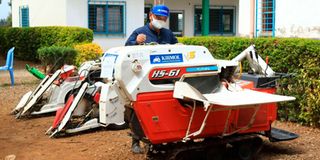
Takeyuki Karasawa operates a walking rice transplanter at Mwea Irrigation Development Centre on September 15, 2021.
Seeds of Gold
Premium
Machines for precision farming of rice
On many smallholder farms, farming activities are done manually, from planting to weeding, harvesting and threshing.
While this has been the norm for ages, the need for precision and efficiency demands that farmers embrace mechanisation at every stage of production.
Well, the issue of cost has been a major hindrance for many smallholders, but a number of firms are taking care of this. They are introducing not only affordable machines but farmers can also now buy pocket-friendly secondhand equipment.
Such machines were on display at the Mwea Irrigation Agricultural Development (MIAD) centre located at the Mwea Irrigation Scheme in Kirinyaga County this week in an exhibition held by Japanese firm KiliMOL.
Among the equipment on display were transplanters, weeders, reapers, threshers and harvesters that can be used by rice (and wheat) farmers.

Takeyuki Karasawa operates a rice transplanter at Mwea Irrigation Development Centre on September 15, 2021.
Transplanting machines
Two categories were on display, that is, riding machines and those for pushing as one walks. The machines are used to pant rice seedlings in the paddy fields.
For the riding transplanter, it plants eight rows at ago, taking about 30-40 minutes to cover an acre.
The machine is loaded with trays where rice seedlings are placed, where they will be picked with forks and planted in the paddy field.
Harun Kimathi of KiliMOLsaid the rice transplanters are the much needed revolution in the rice fields as they will reduce the time spent on the farm and the number of workers hired.
It takes about 18 people to plant an acre of paddy rice, with the farmer paying between Sh400 and Sh600 per person.
On the other hand, the walking transplanter takes about 15-20 minutes of transplanting an acre.
“It is important for farmers not to soak their paddy fields for seven days to avoid sogginess which affects the machines. Three days are enough,” he added

KiliMOL's Yutaka Ikeda demonstrates how a rice weeder works at Mwea Irrigation Development Centre on September 15, 2021.
Weeder
After 21 days of transplanting rice in the field, farmers are required to scout for weeds that if not checked can hamper production.
A weeding machine will help a farmer pick out the unwanted plants from their paddy fields efficiently and faster.
With a spacing of 30cm from one crop to another, the weeder is designed to fit each row.
It is fitted with a blade that removes the weeds in the paddy fields without uprooting or harming the crop.
“It makes work easier compared to hand picking weeds that are time consuming,” said Harun Kimathi of KiliMOL, adding that it is easy to operate, has low maintenance costs and is portable.
A farmer straps the machine on his back and pushes the blade between rice rows to cut the weeds.

Harun Kimathi explains how a binder works at Mwea Irrigation Development Centre on September 15, 2021.
Reaper-binder
Harun Kimathi explains how a reaper-binder works. The machine reaps the crop and at the same time binds it with a string. It bundles the rice straw from end to end of the paddy field while at the same time threshing it. According to Kimathi, it ensures minimal grain loss and lowers the cost of production.
“It takes less time to harvest the crop with this machine due to the less number of labourers needed during harvesting time,” he said. When using a reaper alone, a farmer is required to hire people to carry the harvested rice straws to the thresher.
Reaper
This is an improved sickle. Whereas farmers use one hand to bundle the rice straws, the reaper has a blade that bundles the straws on a holding bay and then chops. A farmer pushes it in the rice fields where it cuts through the straws in the field in a row.
Using the reaper, farmers will need two more individuals to carry the straws to a thresher. Unlike the sickle which compromises on quality of rice, is labour intensive and time consuming, a reaper makes work easier.

An operator explains how a rice harvester works.
Harvester
It takes long hours and days to harvest rice, with the process beginning with draining of paddies. Most farmers harvest their rice by hand using a sickle and then it's laid out to dry for two or three days.
After this, farmers thresh their rice by hand to separate the grain from the stalk. Most farmers thrash the produce on the ground on a polythene sheet to retain the grains before they are milled.
But with a harvester, small-scale rice farmers are able to perform all these duties.
“This machine not only does the tasks but also cushions farmers against post-harvest losses. There is a lot of grain loss when farmers thresh produce by hand,” Kimathi said adding that at the end, it gives farmers clean quality rice free from breakages.
A farmer only requires to drive the harvester into the paddy field, and control the gadget as it cuts, threshes and cleans the grains.
Rice huller and milling machine
The rice huller and milling machine is integrated to sort the hulled brown rice into white rice and rice bran. It is a single pass machine, meaning that farmers can use their household power connection to run it.
“In the process of hulling and milling the rice, it separates broken rice that compromises on quality of rice meaning the milling process is designed to result in long grain rice with minimal breakage,” Kimathi said.
It also gives farmers the luxury of determining how white they want their rice to be as it has an adjustable knob that has numbers indicating the level of rice whiteness.





